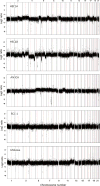Genomic characterization of gene copy-number aberrations in endometrial carcinoma cell lines derived from endometrioid-type endometrial adenocarcinoma
- PMID: 20218740
- PMCID: PMC5120669
- DOI: 10.1177/153303461000900207
Genomic characterization of gene copy-number aberrations in endometrial carcinoma cell lines derived from endometrioid-type endometrial adenocarcinoma
Abstract
Endometrial carcinoma is one of the most common cancers in women. A limited number of endometrial carcinoma cell lines are available for studies of signal transduction pathways and experimental therapeutics in vitro. However, these cell lines have not been comprehensively characterized. In this study, we used genome-wide microarray-based comparative genomic hybridization (aCGH) technology to characterize five of the more commonly used endometrial cancer cell lines. We detected DNA copy-number gains in chromosomal regions 2q, 3p, 3q, 5q, 7p, 17q, and 19q in all five cell lines. Other common sites of copy-number gains, which were detected in four of five cell lines, included segments of chromosomes 1, 6, 8, 9, 11, 12, and 16. In all five cell lines, we found DNA copy-number losses in regions 3p, 10p, 10q, 11q, 11p, 14q, 15q, 18p, and 21q. Other common sites of genetic aberrations included segments of chromosomes 1, 2, 4, 5, 6, 16, 20, and 22. The genes involved in the copy-number alterations included the oncogenes PIK3CA (3q26.3), K-ras (12p12.1), R-ras (19q13.3-qter), Raf-1 (3p25), EGFR (7p12), Akt1 (14q32.32), and Akt2 (19q13.1-q13.2). A pathway analysis showed that genes in the PI3K and Wnt pathways are commonly affected. Our characterization of genomic alterations in these five commonly used endometrial cancer cell lines provides valuable genomic information for research that focuses on these key oncogenic pathways in endometrial cancer.
Figures


Similar articles
-
Distinct chromosomal aberrations of ampulla of Vater and pancreatic head cancers detected by laser capture microdissection and comparative genomic hybridization.Oncol Rep. 2005 Oct;14(4):867-72. Oncol Rep. 2005. PMID: 16142344
-
Chromosomal alterations in 98 endometrioid adenocarcinomas analyzed with comparative genomic hybridization.Cytogenet Genome Res. 2006;115(1):16-22. doi: 10.1159/000094796. Cytogenet Genome Res. 2006. PMID: 16974079
-
Genomic aberrations in carcinomas of the uterine corpus.Genes Chromosomes Cancer. 2004 Jul;40(3):229-46. doi: 10.1002/gcc.20038. Genes Chromosomes Cancer. 2004. PMID: 15139002
-
Screening of DNA copy-number aberrations in gastric cancer cell lines by array-based comparative genomic hybridization.Cancer Sci. 2005 Feb;96(2):100-10. doi: 10.1111/j.1349-7006.2005.00016.x. Cancer Sci. 2005. PMID: 15723654 Free PMC article.
-
Novel molecular profiles of endometrial cancer-new light through old windows.J Steroid Biochem Mol Biol. 2008 Feb;108(3-5):221-9. doi: 10.1016/j.jsbmb.2007.09.020. Epub 2007 Sep 15. J Steroid Biochem Mol Biol. 2008. PMID: 18061438 Review.
Cited by
-
Modeling Endometrial Cancer: Past, Present, and Future.Int J Mol Sci. 2018 Aug 9;19(8):2348. doi: 10.3390/ijms19082348. Int J Mol Sci. 2018. PMID: 30096949 Free PMC article. Review.
-
The EPH/Ephrin System in Gynecological Cancers: Focusing on the Roots of Carcinogenesis for Better Patient Management.Int J Mol Sci. 2022 Mar 17;23(6):3249. doi: 10.3390/ijms23063249. Int J Mol Sci. 2022. PMID: 35328669 Free PMC article. Review.
-
Endometrial cancer and its cell lines.Mol Biol Rep. 2020 Feb;47(2):1399-1411. doi: 10.1007/s11033-019-05226-3. Epub 2019 Dec 17. Mol Biol Rep. 2020. PMID: 31848918 Review.
-
Genome-wide screening for genomic aberrations in Kazakh patients with esophageal squamous cell cancer by comparative genomic hybridization.Int J Clin Exp Pathol. 2018 Jan 1;11(1):427-437. eCollection 2018. Int J Clin Exp Pathol. 2018. PMID: 31938128 Free PMC article.
-
KDM1A inhibition augments the efficacy of rapamycin for the treatment of endometrial cancer.Cancer Lett. 2022 Jan 1;524:219-231. doi: 10.1016/j.canlet.2021.10.019. Epub 2021 Oct 18. Cancer Lett. 2022. PMID: 34673129 Free PMC article.
References
-
- Jemal A, Siegel R, Ward E, Hao Y, Xu J, Thun MJ. Cancer statistics, 2009. CA Cancer J Clin. 2009;59:225–249. - PubMed
-
- Sherman ME, Bur ME, Kurman RJ. p53 in endometrial cancer and its putative precursors: evidence for diverse pathways of tumorigenesis. Hum Pathol. 1995;26:1268–1274. - PubMed
-
- Weber BL. Cancer genomics. Cancer Cell. 2002;1:37–47. - PubMed
-
- Levan K, Partheen K, Osterberg L, Helou K, Horvath G. Chromosomal alterations in 98 endometrioid adenocarcinomas analyzed with comparative genomic hybridization. Cytogenet Genome Res. 2006;115:16–22. - PubMed
-
- Hirasawa A, Aoki D, Inoue J, Imoto I, Susumu N, Sugano K, Nozawa S, Inazawa J. Unfavorable prognostic factors associated with high frequency of microsatellite instability and comparative genomic hybridization analysis in endometrial cancer. Clin Cancer Res. 2003;9:5675–5682. - PubMed
Publication types
MeSH terms
Grants and funding
LinkOut - more resources
Full Text Sources
Other Literature Sources
Research Materials
Miscellaneous

